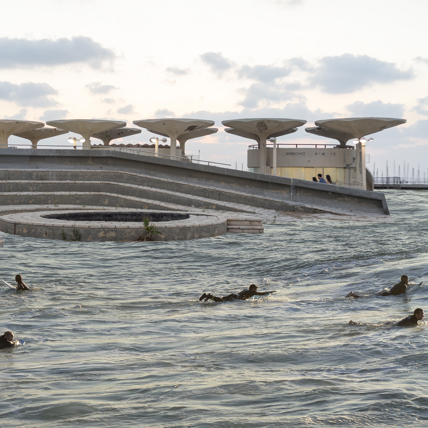Davi Barell | Thousands of Sunsets


In his work, Davi Barell combines photos of familiar sites with collagist additions – elements that were cut out, inlaid, or distorted in the urban image using online materials, generic landscape images, and his own photos. Barell’s new body of work continues his exploration of the urban space and the tension between the architectural ideal and its realization in everyday life.
The focus of the works featured in the exhibition is Atarim Square: an ambitious urban site built in the 1970s in a brutalist style. Architects Yaakov Rechter and Werner Joseph Wittkower designed the square with the aim for it to serve as a nightlife hotspot overlooking the beach, but over the years it has become a symbol of neglect and failure, and an object of public ridicule. An ideal that was never fulfilled. Recently, a plan to demolish and replace it with luxury towers has been approved.
The installation “Thousands of Sunsets” consists of two wallpaper works that face one another, a collage, and two video works. The first wallpaper covers the entire wall, almost: in its center, Barell incorporated the iconic staircase of the square, empty of people, “embedded” in a foreign mountain landscape. The second wallpaper work includes cut outs of elements from the square: two street lamps and a bench, integrated directly into the museum wall. The third work features the artist himself, lying on the square floor and covered in it: perhaps sleeping, maybe buried, possibly offering himself as a sacrifice on the urban altar.
“Thousands of Sunsets,” which gave the installation its name, is a video collage of sunsets over Atarim Square and Gordon Beach at its foot. It comprises images from the artist’s personal archive and the Internet, combined with various elements from the square itself. The work’s soundtrack is the song “One Sunset,” performed by the singer Adam (lyrics: Alona Kimhi, music: Izhar Ashdot).
In the video “Mushroom” (displayed on the museum’s second floor), Barell films his hand at various corners of Atarim Square, holding a cut-out image of a mushroom – alluding to the architectural element identified with the square, which has already been removed. Barell reinstates the mushroom in the complex, an action received (mostly) with indifference by passersby.
For Barell, Atarim Square is a dream destination – a realm of childhood and adolescence, private and public memory, and an unrealized fantasy. His lament for the place is a living action: an attempt to revive the site as a timeless domain of erasure, addition, and disruption. In these works, he offers a bittersweet and emotionally charged tribute to a failed public space that has become a disremembered urban symbol - a “Requiem for Atarim Square.”

